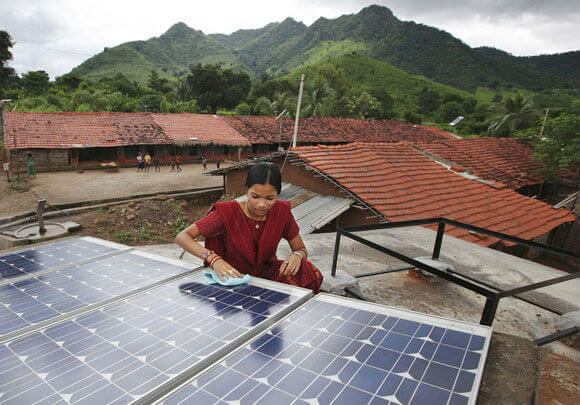
The New York Times reports: A few years ago, the hundred or so residents of Paradeshappanamatha, a secluded hamlet in the southern Indian state of Karnataka, gathered along the central pathway between their 22 densely clustered homes, and watched as government workers hoisted a solar-powered streetlamp. As the first display of electricity in the town, it was an object of mild interest, but, being outside, the light didn’t help anyone cook or study, and only attracted moths.
Still, when B. Prasad arrived two years later to encourage people here to abandon kerosene lighting for solar-powered home systems, people had some idea what he was talking about. What sounded preposterous to the village residents was the price. Mr. Prasad, an agent for Solar Electric Light Company, or Selco, was selling a panel and battery that would power three lights and an attached socket for phone charging for approximately 12,800 rupees, or $192.
“There was no way we could afford that,” P. C. Kalayya remembers thinking. He and his neighbors rise early in the morning to walk miles along a nearly impassable dirt road to work on coffee, pepper and betel nut plantations. Mr. Kalayya earns $3 a day — he’d been earning $2.25 until a raise came through this year — and half his wage is withheld by his employer as repayment for various loans.
And yet, despite what seemed on its face an impossibly high cost, Selco agents succeeded in persuading Mr. Kalayya and 10 other village households to make the switch. Now, his wife can better see how much spice she is putting in as she cooks, and Pratima, their 18-year-old daughter, can study long after dark.
The idea behind Selco, and other companies like it, is to create a business model that will help some of the 1.2 billion people in the world who don’t have electricity to leapfrog the coal-dependent grid straight to renewable energy sources.
About a quarter of the world’s off-the-grid people, or 300 million or so, live in India, mostly in remote, rural communities like Paradeshappanamatha, or in informal urban settlements. Hundreds of millions more get electricity for only a few hours a day. Prime Minister Narendra Modi has pledged to achieve universal electrification in India by the end of 2022. His main effort is adding hundreds of new coal plants, which have contributed to near-apocalyptic pollution levels across large swaths of the country. [Continue reading…]

